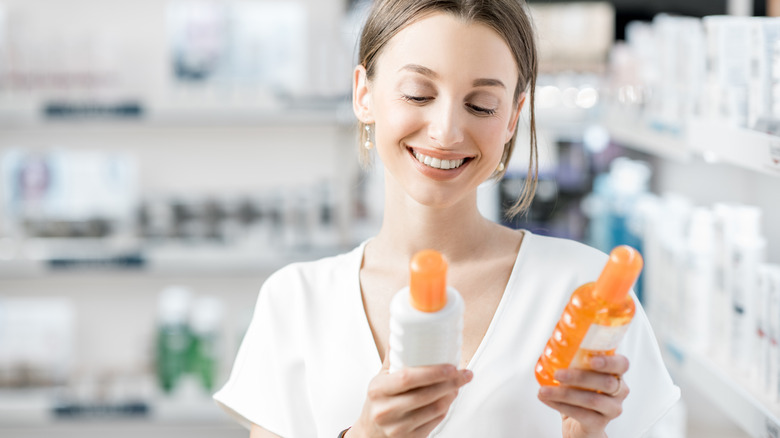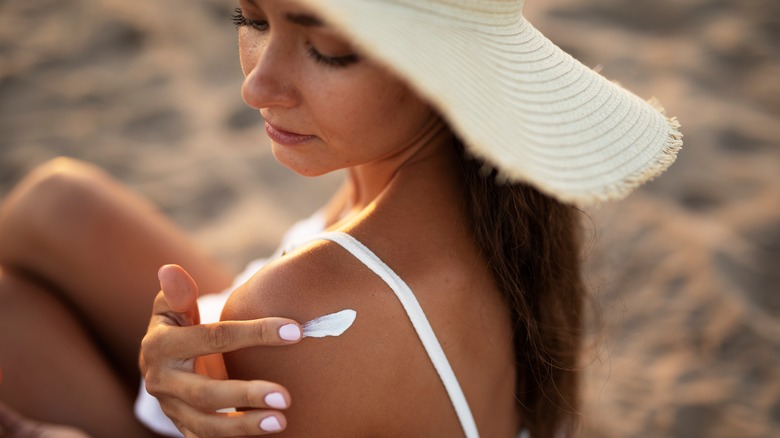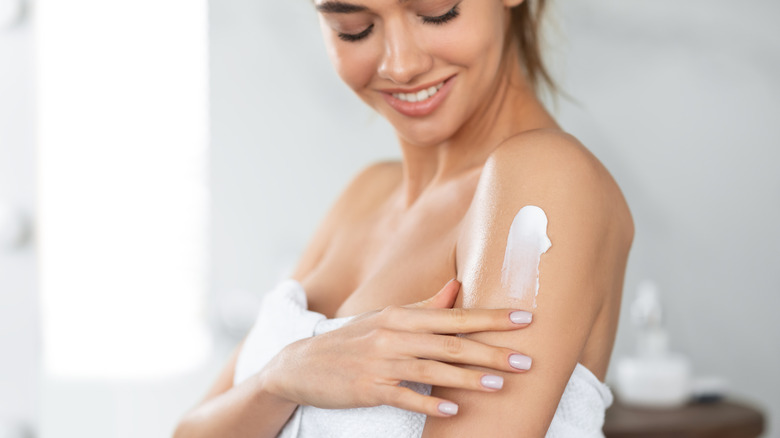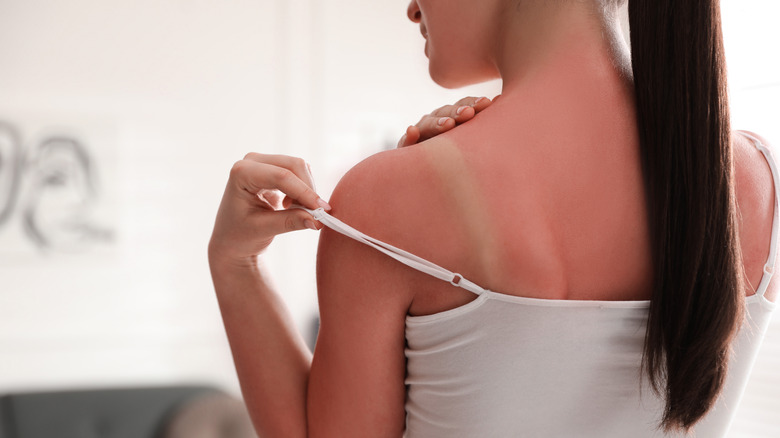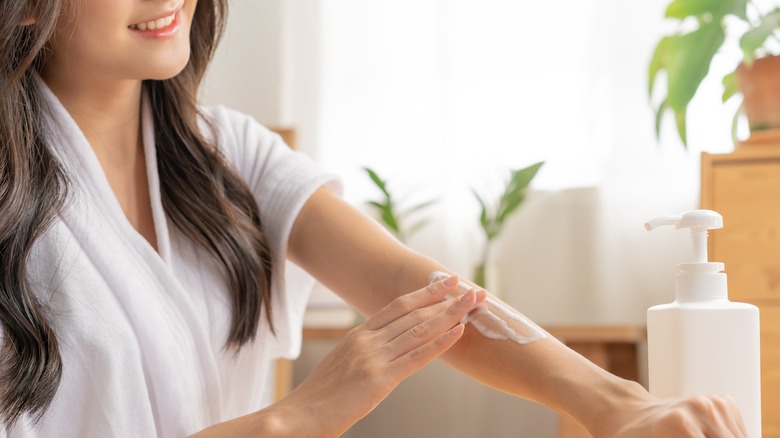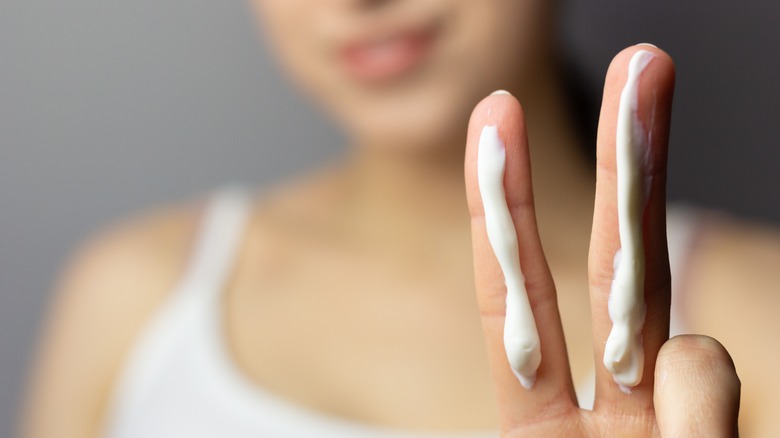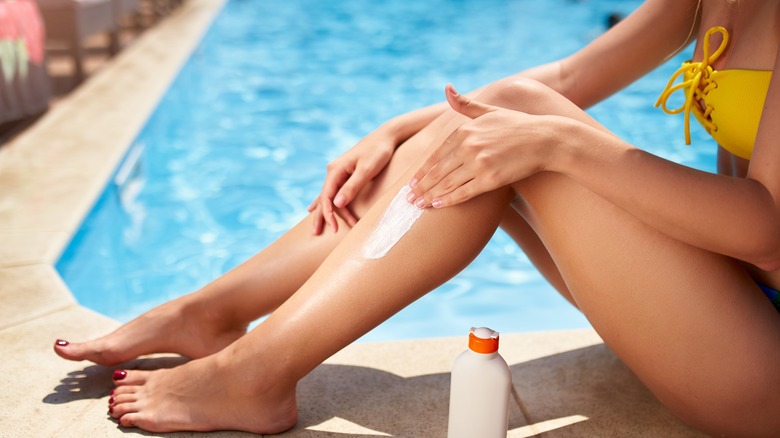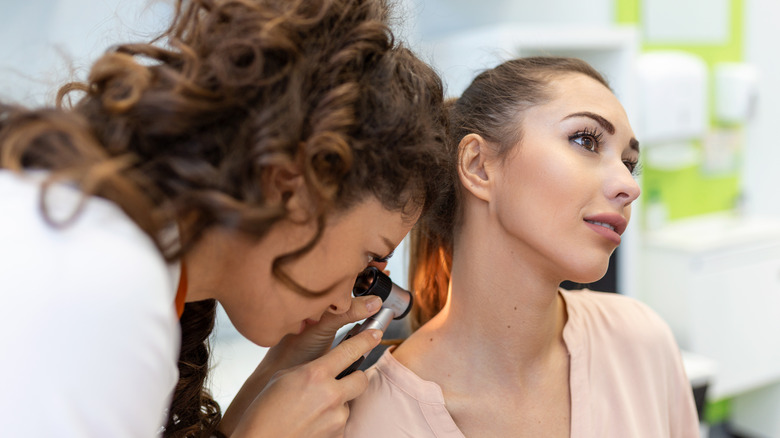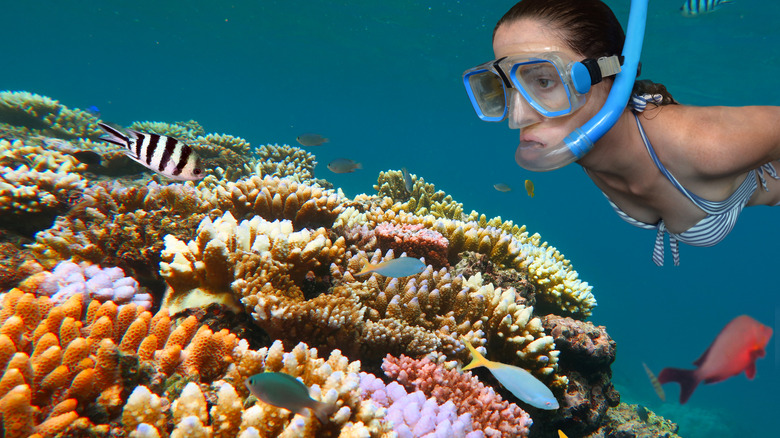Your Ultimate Guide To Decoding Sunscreen Ingredient Labels
Sunscreen is one step in the strategy that we can use to protect against skin cancer and premature skin aging. While it is not a cure-all against the effects of sun radiation, it does go a long way towards preventing the sun's rays from damaging skin in a few different ways. However, certain individuals are more predisposed to sun issues.
As the Skin Cancer Foundation explains, your genetics, overall health, and any skin conditions you may have can put some people at more risk than others. While everyone, regardless of their background, should consider applying sunscreen, it's also essential to know how this product actually works to ensure you get the best protection from sun damage.
By learning about the ingredients in sunscreen, you can better understand what it is actually protecting you against and whether the ingredients themselves pose any risk. For instance, as we will discuss, there are specific chemicals in sunscreens that may not be as safe as first thought. The FDA highlights that some of the active components in sunscreen can stay in the bloodstream long after use. Though it says this may not necessarily be a bad thing (in that it is harmful), more research is needed to examine its use in the long term.
What are the ingredients you need to know about?
According to Chemical and Engineering News, sunscreens have three main components: active ingredients, passive ingredients, and additives. The active components, also known as the sun filters of sunscreen, make up, on average, 20% of the formula. Sun filters consist of any ingredients that physically or chemically absorb or block radiation from the sun. The idea in both cases is that minimal UV radiation actually reaches the skin, preventing damage.
The next component making up roughly 55% of sunscreen ingredients are those which are considered passive. The primary role of passive ingredients is to keep the sunscreen formula stable. For instance, passive ingredients help control the sunscreen's thickness, viscosity, and dispersion. Generally, they're not designed to protect against the sun, only to hold the active and additive ingredients together.
Lastly, an average of 25% of the sunscreen formula is composed of additives. These are any aspects of the sunscreen that contribute to its likening value, such as fragrances and the feel and color of the product. For instance, we often see sunscreens that market the addition of coconut, almond, and scented oils — these are additives that don't affect the product's overall effectiveness but may be desirable to consumers.
Active ingredients
According to the FDA, some of the most common active ingredients used as sun filters are avobenzone, octisalate, octocrylene, homosalate, oxybenzone, octinoxate, titanium dioxide, and zinc oxide (descending by popularity). However, of these, only two are viewed as both generally safe and effective in recent research by the FDA — namely, zinc oxide and titanium oxide, which incidentally fall at the end of their list.
The FDA's research considered a number of factors that contribute to the safety of active sunscreen products, including both clinical and toxicological data on a wide spectrum of active ingredients, looking at how well they protect against sun damage, their duration, and any applicable side effects, such as irritation. The FDA suggests that only two currently met an acceptable standard based on these criteria, and because of these findings, it has since proposed amending all sunscreen ingredients, requiring them to meet a new standard of performance.
You can find the reasoning behind implementing these new stringent rules in various research. For instance, in the Journal of Photodermatology, Photoimmunology & Photomedicine, researchers note organic compounds like oxybenzone and many of the others at the top of the FDA list get absorbed into the skin, which can go on to cause hormonal disruptions as they enter the bloodstream. Their concentration in sunscreen formulas will likely be reduced under the new FDA proposal since they far exceed what the current research recommends.
Passive ingredients
Next, the passive ingredients in sunscreen act as the glue that binds the formula together. Specifically, two main components do this: solvents and emulsifiers. Solvents dissolve or disperse substances within them, whereas emulsifiers hold together substances that do not mix naturally, such as water and oil.
The most common solvent ingredients in sunscreens are usually water (sometimes written as aqua), alcohols such as benzyl alcohol, vegetable and animal oils, and silicones. What's more, silicones often have a dual function, helping to both disperse and help to bind ingredients together. The Journal of Advances in Colloid and Interface Science highlights there are two main types of emulsifiers: surfactants and polymers.
Surfactants work by reducing the surface tension between two immiscible liquids. Polymers do a similar job binding together components that don't usually mix while also acting as a thickening agent to the formula. For surfactants, we see that stearic acid (a fatty acid) is often used with some combination of fat or oil to achieve this effect. For instance, you might find glyceryl stearate and PEG-100 stearate in a typical list of sunscreen ingredients. Conversely, polymers are often some kind of acrylate derivative, an acrylic acid salt. Lastly, you may also find a large bulk of the ingredients are preservatives designed to prevent microbial growth and increase the product's longevity. These are often some form of glycerin or paraben-based ingredients.
Additives
The other ingredients you need to be aware of are usually moisturizers, fragrances, and emollients, which give the product an overall pleasant feel on the skin, making it feel hydrated. These ingredients can vary from product to product based on the brand and how they market their product. For instance, the Journal of Applied Pharmaceutical Sciences and Research explains that close to 3,000 chemical fragrances control the scent of sunscreens and other cosmetics. Even those who list fragrance-free formulas actually add fragrances that mask the smell of the product.
Moisturizers and emollients are usually easier to identify. These might include water-attracting agents called humectants, such as glycerine, or those that prevent water loss, like petroleum-based ingredients, paraffins, silicones (you can often spot these by the "cone" suffix added at the end of the ingredient), or mineral oils. Emollients have a slightly different function than these moisturizers.
According to the New Zealand Trust dermatological resource DermNet, emollients are used to "soften and smooth skin." They work by covering the skin with a protective film which can soothe irritation and act as a barrier to lock in moisture. You might see these listed as some form of lanolin obtained from sheep's wool, bee wax, a stearic acid derivative, or plant sterols (a protein found in plant cell walls).
What role do active ingredients play in SPF?
Surprisingly, SPF is not actually a measure of sunscreen efficacy. SPF (sun protection factor) compares how much solar radiation is needed to burn protected vs. unprotected skin. This means that applying an SPF 15 sunscreen would give you 15 times more protection than unprotected skin against sunburn damage.
Even at a low SPF, you still get some protection, but the higher the SPF factor you use, the more effective the sunscreen will be against deterring sun damage. This is particularly important because you are more vulnerable to sun exposure at certain times of the day. For instance, the FDA explains that you might get the same amount of sun exposure if you stand under the sun for "one hour at 9:00 a.m." or "15 minutes at 1:00 p.m." It's also worth noting that ighter skin may burn faster than darker skin regardless of the time of day.
The active ingredients in sunscreen help to extend the time you spend under the sun without getting burnt, but it's important to understand that this differs from SPF measures. Mainly, this is because SPF is calculated based on UVA exposure. Unless the sunscreen explicitly shows the SPF factor of UVB radiation, then you can assume that this is not a broad-spectrum sunscreen. The FDA requires that any brands claiming a product is "broad spectrum" also test UVB, which should be apparent on the labeling.
What you need to know about UVA and UVB
There are three types of sun radiation: UVA, UVB, and UVC (per the FDA). UV is short for ultraviolet radiation. It is just under the range of visible light on the light spectrum, measured by wavelengths. Each category of UV, from A to C, goes in descending order from the longest wavelength (UVA) to the shortest (UVC).
Because of UVA rays' length, these typically have the most impact on the skin. As Montrose Dermatology and Cosmetics explains, UVA has the most penetrative power, reaching several layers down into the skin, followed by UVB, which can go down two layers, and UVC, which just about passes through the first layer. As you might have guessed, this is why UVC isn't often mentioned in suncare protection, as it isn't as damaging as its counterparts.
Active sunscreen ingredients have different capabilities in reducing or preventing the damage of UVA and UVB, with the majority focusing on UVA, which is the most damaging. However, as mentioned, broad-spectrum formulas can also protect against UVB. That said, it is still recommended that you should apply at least 2 mg. of sunscreen per centimeter squared of skin, as research by the Journal of Clinical and Aesthetic Dermatology points out that people often use just a quarter of this amount.
What does the PA + index mean?
As the VinMec International Hospital illustrates, the PA index, or protection factor index, is based on how much UV exposure would be necessary to pigment (i.e., darken) skin over two to four hours. A UV filter with a low protection grade, such as PA+, would mean skin will darken within two to four hours, whereas a high protection grade filter like PA+++ would protect skin for eight hours or more.
Similar to SPF, it calculates the difference between protection grades based on how protected and unprotected skin would respond to sun exposure. However, the difference with the PA index is that it uses a time threshold rather than the amount of exposure. Overall, there are four levels on the PA index, and you will usually find this along with the SPF, written like "SPF 30 – 12" (the latter digit relating to the PA index). The "12," in this case, would be equivalent to PA+++ because each "+" measures a period of four hours — i.e., 12 divided by four is three.
However, according to research in the Journal of Clinical and Aesthetic Dermatology, you should still reapply sunscreen every two hours regardless of PA factor protection. Many people think that once the sunscreen is applied, that's the end of it. However, you will likely sweat throughout the day, which means you'll lose protection over time. You should reapply if swimming, changing clothes, or toweling, as this can reduce your sunscreen cover, too.
The difference between physical, chemical, and mineral sunscreens
First, physical and mineral are not two distinct types of sunscreen; they are the same thing. Physical sunscreens contain active mineral (i.e., inorganic) ingredients such as titanium dioxide and zinc oxide, which act as a "physical" barrier to reflect UV light from the skin's surface. They do not absorb into the skin, instead leaving a chalky, white appearance. As such, physical sunscreens offer the most protection. "With physical blockers, if you can still see it, it's still working," dermatologist Anisha Patel, M.D., tells The University of Texas Cancer Center.
Chemical sunscreens, on the other hand, contain organic ingredients that absorb UV radiation, convert it into heat, and then release it from the skin. Some active ingredients in chemical sunscreens include oxybenzone, avobenzone, and octinoxate. They are available in cream and spray form, and their application is more comfortable than physical sunscreens. But since chemical sunscreen works through absorption, there has been some concern, as demonstrated in the Journal of Cutaneous Medicine and Surgery, as it may adversely affect your health and the environment.
For instance, student research at Rappahannock Community College highlights that in a study of over 650 sunscreen products, nearly two-thirds were either harmful or ineffective — particularly in the case of oxybenzone, which can accumulate in blood and water and even cause damage to DNA. Thus, there has been a push to move to mineral sunscreens to avoid these issues.
Does water-resistant sunscreen really work?
Yes and no. Typically, the ingredients used to create water resistance in sunscreen come from some form of wax or silicone, such as trimethyl silicate, which acts as a water-repellent. However, you should always take water resistance claims with some skepticism. For instance, a recent Which? testing round of two well-known international sunscreen brands found that the efficacy of SPF fell by "59% after 40 minutes of immersion in saltwater."
While the Journal of Cutaneous Medicine and Surgery states that water-resistant labeling of sunscreen is determined by how well it binds to the skin and withstands adverse conditions such as swimming, sweating, friction, and removal through other physical contacts, the manufacturer's level of testing can be quite different from reality.
This has been highlighted in the International Journal of Cosmetic Science, which found that water-resistant sunscreens tend to perform worse in in vivo (on human skin) testing than manufacturer testing because the manufacturer's tests were done in only mildly agitated and often chlorinated (as opposed to salt) water. In real testing, splashing, water friction, and waves lowered the efficacy of water-resistant products far more than indicated by the manufacturers.
What does dermatologically tested sunscreen actually mean?
"Dermatologist tested" and "dermatologically tested" labels are commonly found on sunscreens and cosmetics products as a way for brands to demonstrate that their products are trustworthy. But as dermatologist Dr. Dray explains, when a sunscreen product claims to be dermatologically tested, it simply means that a dermatologist or a doctor somewhere has used the product. However, it does not necessarily mean that the dermatologist or doctor approves of the product or that it is the consensus of dermatologists everywhere that people should use it.
In fact, the claim "dermatologically tested" may have been obtained through a consumer survey that gathered feedback on what products dermatologists would or would not recommend. That isn't to say that a product that doesn't make this claim isn't safe or approved. The FDA ensures sunscreen manufacturers are legally responsible for ensuring that their products are safe when used according to the directions on the labeling, as well as in the way that you'd traditionally expect to use the product.
Although the FDA doesn't require specific tests on sunscreens or any cosmetic products, manufacturers can use safety data already available on individual ingredients and products with similar formulations. While this might suggest to some that no testing is occurring, the key point is that manufacturers still have the legal responsibility to ensure the safety of their products, including sunscreens. They also have to use safety data or perform additional tests to make claims regarding a product's efficacy.
Should you opt for reef-safe and reef-friendly labels?
Naturally, there is a growing concern that chemical sunscreens can negatively affect the environment, particularly for aquatic ecosystems where sunscreens get washed into the waters and cause long-term damage. According to the Journal of Integrated Environmental Assessment and Management, chemical UV filters can be detected in various water sources worldwide and are not easily removable by standard wastewater treatment techniques.
The concentration of these filters is usually low. Still, high concentrations of oxybenzone and other chemical UV filters do occur and can have adverse consequences on coral — namely, a phenomenon known as coral bleaching. As the National Ocean Service describes, this is when coral reefs lose their color and turn white or pale due to stress.
Certain sunscreens chemicals, such as oxybenzone and octinoxate, can induce this bleaching, damaging DNA and deforming young coral. It can also cause damage to the immune systems and disrupt the growth of sea plants and mammals. Therefore, the environmental organization Save the Reef recommends using mineral sunscreens or those bearing the reef-safe label to prevent these outcomes.
